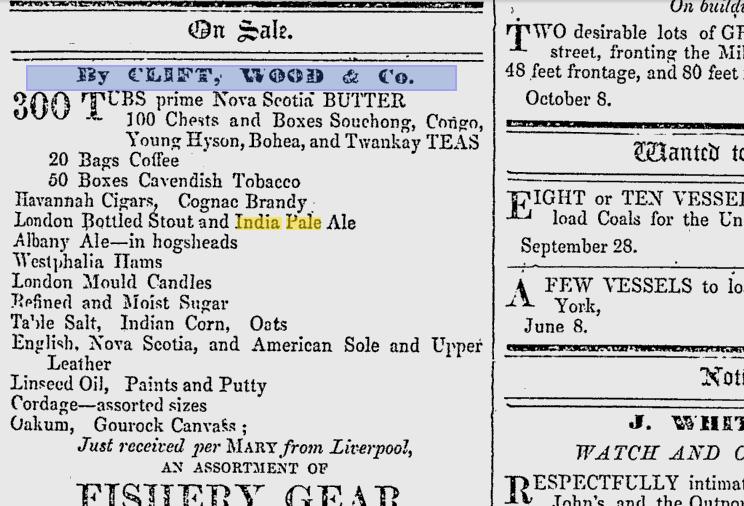Another great time was had by all even if we had to play 18 innings of 1864 rules baseball in a row on a 85 F day under the beating sun. The Kingston St. Lawrence VBBC tied the Sackets Harbor Ontarios 12-12 in the first game and lost 7-1 to the Genesee Nine of Rochester. Highlight was the nine run second inning in the first game. Low light was being on base and realizing I was not actually aware of the rules one needed to know when being on base. Got tagged out at home in the fourth inning of the second game. You know, one truly ought to give ‘er when one has the opportunity.
Category: 1800s
Stuck In My Own Town’s Mid-1800s Beery History
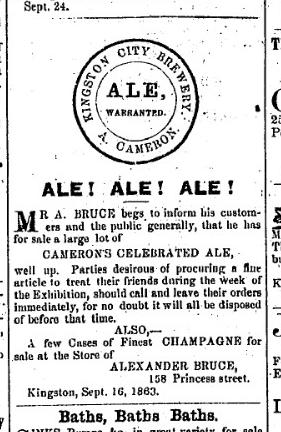 I had intended to get into the 1900s but have gotten stuck in the newspapers out of my town from the nineteenth century. From its first days at the western edge of the British Empire, as this pretty poor image of an early 1800s map shows, Kingston had a Brewery Street. Its still there even if renamed Rideau. We still have some of our Victorian and maybe even Georgian brewing buildings, re-purposed for other things.
I had intended to get into the 1900s but have gotten stuck in the newspapers out of my town from the nineteenth century. From its first days at the western edge of the British Empire, as this pretty poor image of an early 1800s map shows, Kingston had a Brewery Street. Its still there even if renamed Rideau. We still have some of our Victorian and maybe even Georgian brewing buildings, re-purposed for other things.
Who wouldn’t get interested with ads like the “ALE! ALE! ALE!” Kingston City Brewery ad from page 3 of the Kingston Daily News on 8 October 1863. Interesting to see that the copy editor had not that much imagination give the “Baths! Baths! Baths!” header for the next ad. The City Brewery was on the waterfront and I think is long gone but the shop the beer was being sold at 158 Princess Street may well still be there, it’s just selling mens’ clothes now.
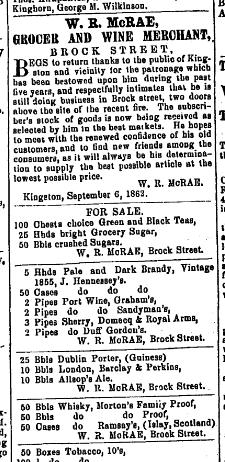 Kingstonians were not only enjoying local brewed beers, however celebrated, in the early 1860s as the ad to the left from the same paper’s 7 October 1862 issue shows. Mr. McRae of Brock Street had plenty of barrels of the empire’s finest Guinness, Barclay Perkins as well as Allsopp beers to be had – along with a range of imported sherries, ports and brandies. The Morton’s “Family Proof” Whisky he offered was locally made. Not sure that it was immune from family members absconding with it or if it had been, conversely, subject to the proof and acceptance by all family members. The Morton distillery and brewery buildings are also still with us and currently under redevelopment as an arts hub. The building which held MacRae’s shop could well be there, too. Another Brock Street store, Cooke’s which opened in 1865, still operates.
Kingstonians were not only enjoying local brewed beers, however celebrated, in the early 1860s as the ad to the left from the same paper’s 7 October 1862 issue shows. Mr. McRae of Brock Street had plenty of barrels of the empire’s finest Guinness, Barclay Perkins as well as Allsopp beers to be had – along with a range of imported sherries, ports and brandies. The Morton’s “Family Proof” Whisky he offered was locally made. Not sure that it was immune from family members absconding with it or if it had been, conversely, subject to the proof and acceptance by all family members. The Morton distillery and brewery buildings are also still with us and currently under redevelopment as an arts hub. The building which held MacRae’s shop could well be there, too. Another Brock Street store, Cooke’s which opened in 1865, still operates.
The town seems to have had a fairly rich relationship with beer and other alcohol but it was not all fun and games as this 1867 article from The New York Times explains. The watchman Mr. Driscoll of what is likely the same Morton works was murdered the year before during a burglary. His Detroit murderer was sentenced to hang. They’ll each both be still here, too – buried around here somewhere. The town is like that.
Who Made Ontario’s First Lager And Where?
 In the 1868-69 edition of Sutherland’s City of Hamilton and County of Wentworth Directory there is listed a little listing that says “Eckhardt, August, brewer, Hamilton Lager Beer Brewery…” This corresponds with Sneath‘s first listing for a lager brewery in 1868 which states:
In the 1868-69 edition of Sutherland’s City of Hamilton and County of Wentworth Directory there is listed a little listing that says “Eckhardt, August, brewer, Hamilton Lager Beer Brewery…” This corresponds with Sneath‘s first listing for a lager brewery in 1868 which states:
Edward Eckhardt opens the Hamilton Lager Brewery in Hamilton and it closed three years later.
The name is right as Albert is confirmed as the brewer and Edward the proprietor in another section of the directory. So they must have started lager beer there. No one else is listed even if the Spring Brewery established in 1868, makers of “ale, porter, beer, etc., in great quantities, either in wood or bottle” are working on “an addition is now being made for an ice house.” Except for one thing. In the same directory there are at least six listings under “lager beer saloon” with proprietors with the names Goering, Grell, Kerner, Mansfeld, Schaupp and Winckler. Maybe more. How could all those businesses get up and running selling lager beer in time to get printed in the directory in the same year that the brewery opens? Could it be that the saloons pre-dated this brewery? Oh, for a copy of the 1866-67 edition of Sutherland’s City of Hamilton and County of Wentworth Directory!
I dunno. I do know that the author of this travel piece about Kingston, Ontario published in The New York Times in 1890 states “in all my travels extending through hundreds of miles of Ontario, beginning at this place, [I] have seen the sign ‘lager beer’ displayed only once.” Ontarians were long time pale ale and stout hold outs when their southern mid-Atlantic and mid-western US neighbours were following their immigrant Teutonic ways and breaking out the lager, much to the chagrin of 90 year old Charles H. Haswell in 1899, as is discussed in Maureen Ogle’s book Ambitious Brew.
 There was another issue, of course, in that the rush of German immigrants was more of a late 1800s rather than mid-1800s event here. There needed to be cold. And the first refrigeration system in Canada is only turned on, according to Sneath, in 1886 in Montreal. So… we had ice houses… and folks doing what they could… figuring out the large investments required compared to the smaller population centres and… well, when you figure all that out… wouldn’t you really like a nice old fashioned trusty Ontario stock ale?
There was another issue, of course, in that the rush of German immigrants was more of a late 1800s rather than mid-1800s event here. There needed to be cold. And the first refrigeration system in Canada is only turned on, according to Sneath, in 1886 in Montreal. So… we had ice houses… and folks doing what they could… figuring out the large investments required compared to the smaller population centres and… well, when you figure all that out… wouldn’t you really like a nice old fashioned trusty Ontario stock ale?
The King Brewery Pilsner clocks in at a sessionable 4.8%. It pours an actively carbonated burnished gold that supports a rich white froth and foam. On the nose, there is plenty of pale malt and graininess with Saaz hopping. In the mouth a jag of steely mentholated spicy herbal weedy hops but plenty of rich maltiness to back it up, more bread crust and biscuit that malteser. A complex beer with waves of flavours. Plenty of BAer respect.
Ontario: Stock Ale, Mill Street Brewery, Toronto
 Where was I? The 1830s and 40s? About there. Local breweries popping up as settlers move west, filling up southern Ontario right up to the Lake Huron coast. Familar names start popping up. In 1835, James Morton is operating out of the old Molson brewery on the Kingston waterfront. John Sleeman starts up in 1836. In 1843, Thomas Carling builds a brewery in London, Ontario. And in 1847 John Labatt enters into a partnership with an existing brewer also in London and Quebec brewers Molson have another go, this time further west along the Lake Ontario shore at Port Hope. It lasts until 1868. Facts stolen from Sneath.
Where was I? The 1830s and 40s? About there. Local breweries popping up as settlers move west, filling up southern Ontario right up to the Lake Huron coast. Familar names start popping up. In 1835, James Morton is operating out of the old Molson brewery on the Kingston waterfront. John Sleeman starts up in 1836. In 1843, Thomas Carling builds a brewery in London, Ontario. And in 1847 John Labatt enters into a partnership with an existing brewer also in London and Quebec brewers Molson have another go, this time further west along the Lake Ontario shore at Port Hope. It lasts until 1868. Facts stolen from Sneath.
A number of the brewers are also distillers, maltsters, flour millers and a bunch of other things. Which leads me to my first utterly unfounded theory of beer in Ontario. It is related to this beer. When I think of Canadian pale ale, this is the taste I associate with it. It’s ale-y. A musty quality that tastes like the Legion Hall dance or a curling tournaments in 1956. Or 1907. Or 1877. It’s heavy on the grain. Given the small scale farming economy of the first and second generations of most of southern Ontario to the west of Toronto through the mid-1800s, the same entrepreneurs were likely handling all sorts of grains and distilling some, brewing with others.
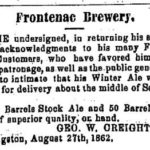 They had to make products that both reflected and appealed to their clients and the environment. The had to go with a shot of whisky – whether it was made with barley or rye. In 1862 here in Kingston, Mr. Creighton of the Frontenac Brewery was selling stock ale and porter with the promise of a winter beer in the fall. Farther to the west in 1872, Labatt is selling only pale ale and stout in its local paper.
They had to make products that both reflected and appealed to their clients and the environment. The had to go with a shot of whisky – whether it was made with barley or rye. In 1862 here in Kingston, Mr. Creighton of the Frontenac Brewery was selling stock ale and porter with the promise of a winter beer in the fall. Farther to the west in 1872, Labatt is selling only pale ale and stout in its local paper.
The Mill Street Stock Ale pours the colour of a pine plank in a lumber yard and resolves to a thin rim and froth. But it’s that smell – like a bag of wet grain. In the mouth there is a round ball of pale malt sweetness and, then, a heck of a lot of drying grain huskiness. The huskiness is joined by a measured but roughish sort of hop in the finish – more weedy than twiggy. I don’t know how this compares to an 1862 Frontenac Stock but I can day dream about it. Worth more respect than the BAers give it.
Why Did Ontario Beer Have To Make Its Own Way?
 Why did Ontario have to make its own path to beerdom? Well, a war and a river for one thing. As we discussed yesterday, the land that is now Ontario was settled in 1783-84 by Loyalist refugees from New York state after the American Revolution. For the first five years, Kingston is a military town without civic government. Over the years that follow until about 1843, it is the leading town in the new British colonies of Upper Canada and then Canada. But the threat of war with nearby America hovers over it well into the 1860s. Kingston sits where the first Great Lake meets the St. Lawrence River which flows on past Montreal, past Quebec and out to the sea. For well over the first hundred miles of that flow, the south shore of the river is in US hands as are half of the islands. And that made shipping drink to that spot particularly difficult as this summary of a letter to the Governor of Canada dated 11 May 1783 suggests:
Why did Ontario have to make its own path to beerdom? Well, a war and a river for one thing. As we discussed yesterday, the land that is now Ontario was settled in 1783-84 by Loyalist refugees from New York state after the American Revolution. For the first five years, Kingston is a military town without civic government. Over the years that follow until about 1843, it is the leading town in the new British colonies of Upper Canada and then Canada. But the threat of war with nearby America hovers over it well into the 1860s. Kingston sits where the first Great Lake meets the St. Lawrence River which flows on past Montreal, past Quebec and out to the sea. For well over the first hundred miles of that flow, the south shore of the river is in US hands as are half of the islands. And that made shipping drink to that spot particularly difficult as this summary of a letter to the Governor of Canada dated 11 May 1783 suggests:
The want of rum; the Indians have been supplied a little more liberally than usual to keep them in good humour. The honourable and liberal conduct of Hamilton and Cartwright in lending rum, by which they must be considerable losers, only stipulating that a certain quantity of dry goods might be shipped for them at Carleton Island, to which he had agreed. The Indian officers that have resided at the Indian Villages for some time cannot be removed for fear of creating suspicions, but they will be discontinued as fast as circumstances permit, The Indians behave well, but he wishes Sir John Johnson would appear soon.
The Johnson clan, founders of Kingston, were an integrated family of Anglo-American’s and Mohawk. John Johnson’s step-mother was Molly Brant or Konwatsi’tsiaienni so the references to rum and its use describe a bond, not the disrespect and degradation that came in later generations. Almost thirty years before, in 1775 William Johnson, the elder, described his provisions of beer and their purpose in his accounts: on 6 June as ” 2 Barrels beer of Hend’k Fry for the Conajoharees to drink the Kings Health” and again on 22 July of the same year “To a Bull to the Mohawks + 3 Barrels of Beer for a War Dance at their Castle”. Beer and rum were part of the supply requested and required when you were making allies at the farthest end of the reach of the Empire. Because until 1777 – and really for some time later – the Johnsons and their well stocked booze stash are the western end of the British Empire except for a few thinly manned forts.
Which leads to a few observations. If you click on the map above, you will see that there is a route A and a route B to Lake Ontario, the navy filled buffer that protected the Loyalist settlers and later immigrants for their first four decades there. The St. Lawrence, a 112-gun first-rate wooden warship of the Royal Navy along with other cannon laden ships, was built at Kingston in 1814. It was bigger than any other ship in the fleet globally. But it could not reach the sea. Not by route A or route B. The St. Lawrence, route A, was filled with rapids that left the early inhabitants lake locked. Route B fell into US revolutionary hands with the fall of Johnstown in 1777 after thirty years of the upper reaches effectively under control of the one family, one man.
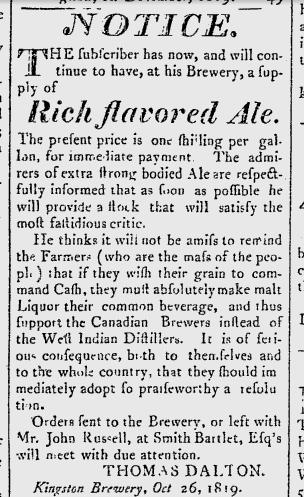 So, how to get beer to Kingston when one route is under constant risk of attack and the other is in enemy hands? Well, you don’t. You have to wait to grow crops and then you have to feed yourself, sell some off for cash and then sooner or later you get to the point that there is enough extra to make beer. Have a look at that ad we looked at yesterday placed in a Kingston newspaper in 1820 by the brewer Thoma Dalton. He is seeking both ale customers and malt suppliers in the local farming community as a means to overcome imported rum, as a means to create a local economy. The next year he is in Montreal with a trial shipment of 100 barrels of “Kingston ale” for public auction. He must have convinced the farmers of Kingston to do business.
So, how to get beer to Kingston when one route is under constant risk of attack and the other is in enemy hands? Well, you don’t. You have to wait to grow crops and then you have to feed yourself, sell some off for cash and then sooner or later you get to the point that there is enough extra to make beer. Have a look at that ad we looked at yesterday placed in a Kingston newspaper in 1820 by the brewer Thoma Dalton. He is seeking both ale customers and malt suppliers in the local farming community as a means to overcome imported rum, as a means to create a local economy. The next year he is in Montreal with a trial shipment of 100 barrels of “Kingston ale” for public auction. He must have convinced the farmers of Kingston to do business.
Over the next decade and a half Ontario continues to fill and local breweries are there. In 1836 there is a brewery for sale or rent in St. Catherines and another at the River Credit at the western end of Lake Ontario. Five years earlier, in 1831 there was a brewery even further to the west serving the 800 residents of the area of Guelph, currently home to micro turned national Sleeman as well as the craft brewers of the Wellington Brewery and the F+M Brewery.
So why did Ontario become a land of local beers made with local products sold to local people? There was really no other reasonable choice, no other good way to get your beer.
The Origins Of Ontario’s Good Beer Tradition
 Beer. It only gets to you in so many ways. You make beer and provide it to your community. You make beer and ship it to another community. You ship beer in and provide it to your community. There are not too many other options for the beer trade whether you are talking about 1810 or 2010. Today we are talking about the late 1700s and early 1800s.
Beer. It only gets to you in so many ways. You make beer and provide it to your community. You make beer and ship it to another community. You ship beer in and provide it to your community. There are not too many other options for the beer trade whether you are talking about 1810 or 2010. Today we are talking about the late 1700s and early 1800s.
The community I happen to live in now, Kingston Ontario, is a lucky choice if you are interested in the history and beer in Ontario as it is where Ontario began. Actually, it was all the Province of Quebec when it began as a British governed community in 1783. At that point, Quebec then ran all the way west and included Ohio and Michigan. The people who first settled here were wealthy Mohawk Valley NY land owners, their slaves, their Mohawk allies and their Loyalist tenant farmers evicted from New York state during the American Revolution. Not the British. This is a community started by battling Yorker farmer warriors.
Allen Winn Sneath in his book Brewed in Canada states that the first brewery in what by then was called Upper Canada was the Finkle’s Tavern, founded a few miles west of Kingston in Bath in 1800. The Ontario historic plaque indicates it was built earlier, in 1786 when the area was still Quebec. Sneath’s book has a photo from the collection of beer writer Ian Bowering. What did they do before then? For the first years of Kingston we are likely looking at locally made home brewed ales, maybe some casks of strong ale being brought in for the wealthy but mainly lots and lots of rum if you go by the ads in the available newspapers. In a way, the tastes of Kingston echo of the community led by Sir William Johnson who died suddenly in upstate NY in 1774 just before the Revolution. He left his affairs to his son John who went on to lead led the Loyalist defense of upstate NY in the Revolution and then because the Superintendent of the resettlement here, the first colonization of the Great Lakes basis under British command. William Johnson was in the habit of importing good strong beer. It’s likely his son, John, continued the practice.
Kingston was still a strong ale town in 1890 according to this article from that year in The New York Times. The town was filled with farmer warriors who would have immediately grown their own grain crops as soon as they hit the shore. In that clip from the Kingston Chronicle of the 3rd of March 1820 above, the first commercial brewer in Kingston, Thomas Dalton, seeks out local grain to make his extra strong bodied ale, even using a nationalist argument to encourage drinking of Canadian beer over West Indian rum.
So, good strong ale was likely being both brewed and brought into Kingston soon after its founding in 1783. And with it came the genesis of the Ontario craft beer trade that continues today.
More Thoughts On That Pesky Albany Ale Question
I have been thinking more about this pre-1850 invention called “Albany ale” and I am a bit surprised to find so many references to it of one sort and so few references of another. The stuff was made in volume, transported and traded over great distances but now seemingly forgotten to memory. As we will see [Ed.: building suspense!] when we discuss the quote above, it was the stuff of memory even at the end of the 1800s.
But what was it? As noted this morning by Robert in the comments, there is a brief description of Albany’s production of ale in the 1854 book The Progress of the United States of America by Richard Swainson Fisher at page 807:
The business of malting and brewing is carried on to a great extent In Albany; more than twenty of such establishments are now in operation, and Albany ale is found in every city of the Union, and not unfrequently in the cities of South America and the West Indies. The annual product is upward of 100,000 barrels of beer and ale.
Similar text was published in the Merchant’s Magazine in 1849 except it was 80,000 barrels. Interesting to see how far it traveled – California, West Indies and South American in addition to references to Newfoundland in yesterday’s post. There is also this passage in 1868’s A history of American manufactures from 1608 to 1860 Volume 1 by John Leander Bishop and a few others:
…Kuliu mentions, in his account of the Province in 1747, that he noticed large fields of barley near New York City, but that in the vicinity of Albany they did not think it a profitable crop, and were accustomed to make malt of wheat. One of the most prosperous brewers of Albany during the last century was Harman Gansevoort, who died in 1801, having acquired a large fortune in the business. His Brewery stood at the corner of Maiden Lane and Dean street, and was demolished in 1807. He found large profits in the manufacture of Beer, and as late as 1833, when the dome of Stanwix Hall was raised, the aged Dutchmen of the city compared it to the capacious brew kettle of old Harme Gansevoort, whose fume was fresh in their memories.’ [Note: Munsell’s Annals of Albany. Pleasentries at the expense of Albany Ale and its Brewers are not a recent thing. It was related by the old people sixty years ago of this wealthy Brewer, that when he wished to give a special flavor to a good brewing he would wash his old leathern breeches in it.]
Was Albany ale originally a wheat ale? It was obviously big stuff in the state’s capital for decades.
Reference to Albany ale also appears in an illustration of a principle in a book of proper English usage. In the 1886 edition of Every-day English: A Sequel to “Words and their Uses” by Richard Grant White where we read the following at page 490:
I cannot but regard a certain use of the plural, as “ales, wines, teas,” “woolens, silks, cottons,” as a sort of traders’ cant, and to many persons it is very offensive. What reason is there for a man who deals in malt liquor announcing that he has a fine stock of ales on hand, when what he has is a stock of ale of various kinds ? What he means is that he has Bass’s ale, and Burton ale, and Albany ale, and others; but these are only different kinds of one thing.
The fifth 1886 edition of Words and their Uses by the same Mr. White contains no reference to Albany ale but does indicate he was a prolific US author who lived from 1821-1885. Does the later use by White imply it was an easily understood example? Probably.
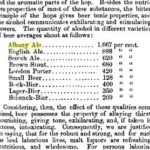 In the New York journal The Medical Record of 1 March 1869, there is an article entitled “Malt Liquors and Their Theraputic Action” by Bradford S. Thompson, MD the table to the right is shown that clearly describes Albany ale as a sort of beer the equal to the readers understanding as London Porter or Lager-Bier. I am not sure what the table means from a medical point of view but it clearly suggest familiarity… at least amongst the medical set.
In the New York journal The Medical Record of 1 March 1869, there is an article entitled “Malt Liquors and Their Theraputic Action” by Bradford S. Thompson, MD the table to the right is shown that clearly describes Albany ale as a sort of beer the equal to the readers understanding as London Porter or Lager-Bier. I am not sure what the table means from a medical point of view but it clearly suggest familiarity… at least amongst the medical set.
In 1875, it is described in a travel book called Our Next-door Neighbor: A Winter in Mexico by Gilbert Haven (who seems to not have been a lover of the drink himself) at page 81:
Here, too, we get not only our last look at Orizaba, but our first at a filthy habit of man. Old folks and children thrust into your noses, and would fain into your mouths, the villainous drink of the country – pulqui. It is the people’s chief beverage. It tastes like sour and bad-smelling buttermilk, is white like that, but thin. They crowd around the cars with it, selling a pint measure for three cents. I tasted it, and was satisfied. It is only not so villainous a drink as lager, and London porter, and Bavarian beer, and French vinegar-wine, and Albany ale. It is hard to tell which of these is “stinkingest of the stinking kind.” How abominable are the tastes which an appetite for strong drink creates! The nastiest things human beings take into their mouths are their favorite intoxicants.
So, along with grammarians and the drinking medical set, Albany ale was also a name known to the non-drinking traveling set in the post-Civil War United States. It was, as a result, something we might consider “popular” in its day.
Oddly, the story of Albany ale does not seem to make it deep into the 1900s. Without making an exhaustive study, I don’t see reference to “Albany ale” in Beer and brewing in America: an economic study” by Warren Milton Persons from 1940. It is not indexed in Beer in America: the early years, 1587-1840 by Gregg Smith. It does not seem to be in Ambitious Brew: The Story of American Beer by Maureen Ogle as it really starts with the the rise of lager is in the second half of the 1800s. Why did it fall so far so fast?
That quote way up there? The one at the top? It’s from an 1899 New York Times article entitled “Kicked 90 Years Ago Just the same as Now” in which a 96 year old New Yorker still employed as a municipal engineer who was interviewed about the City’s old days. Talking about his youth in the 1830s, he said “Albany ale was the beverage then that lager beer is today, and a mighty good drink it was.” So, lager likely killed it off but only after it had its day and was enjoyed widely in the days before rail transportation both within the United States and abroad.
2015 Update: came across book by Mr Haswell, the 96 year old New Yorker mentioned up there.
What The Heck Was “Albany Ale” In 1847… Or 1807?
So I am nosing around looking for India pale ale references on Google news archives when I spot this one in a newspaper from 1847’s Newfoundland to something called Albany ale. In hogsheads no less.
What the heck is it? It is listed in the The Public Ledger of 12 Oct 1847 amongst other imported goods from around the world – even Gourock canvass from the Old Country. In 1853, there is notice again in The Public Ledger of Newfoundland as being “just arrived” in a 50 barrel lot. It looks like an import. Albany ale is listed in the Hartford Courant as far back as issues from 1806 and 1807. In 1846, its for sale in New Orleans and, in 1854, there was a fire at the agents of an Albany ale manufacturer in New York City according to The New York Times. It’s even a drink at a church supper in Adams County, Pennsylvania in 1850.
But what the heck is it? Is it a style? Or is it just an ale from Albany, NY? If so, why is that the pale ale that makes it all the way to Newfoundland?
Allsopp’s Arctic Ale And Arctic Homebrew In 1852
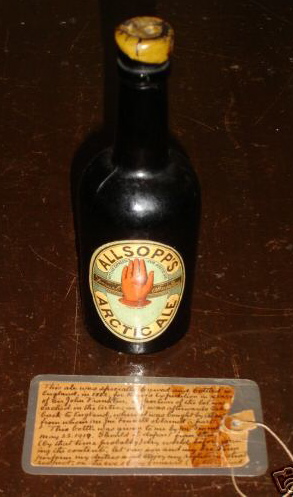 There is a bit of beery backroom buzz about plans to make a movie about the Allsopp’s Arctic Ale, the beer which accompanied a British navy expedition in the Canadian high Arctic in the mid-eighteenth century. The film maker’s website is not up yet but there is a Facebook page which reports:
There is a bit of beery backroom buzz about plans to make a movie about the Allsopp’s Arctic Ale, the beer which accompanied a British navy expedition in the Canadian high Arctic in the mid-eighteenth century. The film maker’s website is not up yet but there is a Facebook page which reports:
Sir Edward Belcher failed on his journey, abandoned four of the five ships in the ice, and returned to England to be court-marshalled (some thanks… huh?). A few of the bottles of Allsopp’s Ale came back to England, where in 2007 a bottle came up on EBay, and reportedly sold for $503,000 (this is what caught my interest). To my knowledge, there are only two bottles left in the world from the 1852 expedition. I have researched this ale in the deepest of all journals and records, both here and abroad. I now have a recipe for this Ale and intend to brew it near the Belcher Islands of the Hudson Bay in the Canadian Arctic.
There is more information hanging about the internets about this stuff and not just pictures of that eBay bottle. Available Arcticky data includes the passage below from the book The Last of The Arctic Voyages by Captain Sir Edward Belcher, C.B. about the failed search for the expedition of Sir John Franklin from 1852 to 1854. The book can be found in its entirety at Google books. Belcher was a bit of a tool in an old school way but, as a fellow Nova Scotian, one has to give him some props but we can leave it at that as far as the admiration goes. He did have a thing for the beer apparently – at least when stuck in the ice – as he noted on 21 December 1852 after the presentation of a pantomime on board his firmly frozen ship: “Allsopp. That name will live for ages in the recollection of all Polars.”
It seems that in addition to filling the hull with Allsopp’s Arctic Ale, Belcher also brought along a home brewing system. Here is the report of the production of beer on board starting around page 339:
Brewing from essence of malt and hops had been practised as early as the 6th of August last season, but the general adoption of our “home-brewed” did not fairly commence until the end of October; with what success I shall leave my readers to judge from the following report of the officer who superintended. It was much esteemed, and at times mixed to dilute the excellent beer supplied by Messrs. Allsopp.
“Her Majesty’s Skip ‘Assistance,’ Wellington Channel,
October 31, 1853.
Sir,
“1. In compliance with your directions, I have the honour to report upon the beer brewed from the essence of malt and of hops on board this ship during the winter 1852-1853, as follows, viz.:—
“2. An experiment was made on the 6th of August, 1852, to brew with the proportions prescribed by the makers (Hudson and Co.). Eighty pounds of malt and three pounds of hops were mixed with boiling water, and then started into a fifty-six gallon cask (filling it), placed by the side of the galley-fire: when the temperature had fallen to 90° there was added half a pound of yeast, in a state of fermentation, made by mixing dried yeast, sugar, and flour, in hot water; but although signs of fermentation were occasionally apparent at the bunghole during the day, yet, from the low temperature that prevailed at night (consequent upon the absence of the galley-fire), it could not be got to work satisfactorily. The beer produced, although palatable and drunk by the ship’s company, was so weak, from the inadequacy of the quantity of ingredients used, and so flat, in consequence of the inability to raise sufficient fermentation, that it was scarcely equal to the smallest table beer.
“3. On the 23rd of October, 1852, the ship being fixed in winter quarters, and the Sylvester warming apparatus at work, maintaining a constant equal temperature, brewing operations were commenced, with the view of keeping up a periodical supply for the ship’s company.
“4. The proportions used were,—essence of malt, 120 lbs., and of hops 4 lbs., to fifty-four gallons of water: these were boiled together for two hours in the ship’s coppers, and then put into a fifty-six gallon cask, which was placed (for the purpose of obtaining the highest temperature in the ship, steady at about 70°) by the side of the funnel of the Sylvester warming apparatus. In about eighteen hours after, the temperature of the mixture had fallen to 90°, when yeast was added, and generally in a few minutes produced vigorous fermentation, which was maintained for seven or eight days, the froth being thrown off at the bung-hole and received from a leather spout, nailed on the side of the cask, into a tub placed on the deck, from which the cask was kept filled as it became necessary, for the first two days almost every hour, and afterwards at longer intervals, as fermentation slackened. As soon as it had ceased to work, the cask was bunged up and removed, to settle and fine for a fortnight; it was then broached for issue.
“5. The beer thus produced was highly prized, and I think I may venture to state that, both for strength and flavour, it was all that could be desired.
“6. From this time (October 23rd) until the end of the following April, a constant supply of this beer was maintained, at the rate of one pint for each person twice, and sometimes three times, a week, besides other occasional extra issues; for which purpose it was necessary to appropriate three fifty-six gallon casks,—one to issue from, the next to settle and fine, and the third in a state of fermentation.
“7. The total quantities of the essences consumed during this time were—of malt, 1620lbs.; hops, 44lbs.; and the beer produced was 702 gallons.
“8. Although the beer thus necessarily issued a fortnight after being brewed was of good quality, yet I would beg leave to remark, that had it been practicable to have allowed it to stand for a longer period (a3 in the case of beer brewed in England), there is good reason to suppose that it would have become scarcely inferior to English porter of the first quality.
“9. There now remain for brewing (to be commenced, in pursuance of your directions, as soon as the hold is cleared), essence of malt, 780lbs.; hops, 40lbs.
“I have the honour to be, Sir,
Your most obedient, humble servant,
James Lewis,
Clerk in charge.”
Captain Sir Edward Belcher, Kt., C.B.,
Her Majesty’s Ship ‘ Assistance,’ and Commanding
Arctic Searching Squadron.
Note Belcher actually calls it home brew. Other than that, I will leave interpretation and further explorations of the explorer’s libations to others who are, you know, cleverer than me. Suffice it to say thank God for what beer these poor bastards could get their hands on 158 years ago, two or three thousand miles to my north.
Big Easlakia Base Ball News Circa 1874
While I was over hobnobbing with the shaken and moved of the southern part of our Easlakian neighbo(u)rhood, I have actual stuff to do. Base ball stuff as I wanted to research the Watertown tournament of 1874 given that there were references to it in the Kingston papers of the time. I had thought that they went to play but in fact it appears that they went to watch as they are not listed as a team in the schedule.
Kingston’s rivals of the day, the Guelph Maple Leaf, win the event held in late June and early July over eight days before pop up here after for a game on 7 July 1874. But there are other notes that make it very curious:
- There is a first and second class tournaments being played side by side making for a total of 14 teams. I do not know why you would have seven teams per class but there you have it.
- Being or rather not being “daunted” meant something in the mid-1870s as there is a second class team called “The Undaunted” of La Fargeville, NY and another second class team called “The Dauntless of Watertown, NY. Careful readers will know that there was also a team called Dauntless of Ogdensburg, NY which the Kingston St. Lawrence played on Friday 8 August 1874 in Ogdensburg as well as the Dauntless Club of Toronto that Kingston played in 1872 and 1873 .
- One team in the first class group was the Ku-Klux of Oneida, NY described as “the acknowledged champion club of Northern and Central New York” in the 29 June issue of the The Daily Times of Watertown. You will be comforted to know that the Maples Leaf of Guelph thumped them 13-4 and that the team was slagged in the paper as “the negro haters” who scored a “usual whitewash,” a “goose egg, ” a “cipher” and “skunked” in various innings.
- Certain players of the Nassaus of Brooklyn, NY and some Eastons of Easton, Pennsylvania were reported in the 6 July issue as having taken a wagon to Sackets Harbor on Sunday 4 July and returning in quite a state: “It would have been proper if the whole crowd could have been unloaded at the jail.” They apparently were driven through Public Square as they sand “Mulligan Guards” and kindred songs.
Thrilling stuff. Need to do a little cross referencing but it looks like the Eastons of the 1870s may have been a rival to the Philadelphia Athletics which are now the Oakland A’s.



